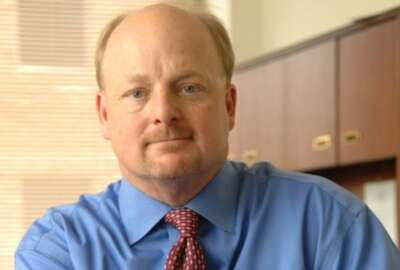Next two weeks crucial for agency budgets
Steve Bell, the senior director of economic policy at the Bipartisan Policy Center, joined the Federal Drive with Tom Temin and Amy Morris to provide an update into...
wfedstaff | June 4, 2015 1:54 pm
By Michael O’Connell
Web Editor
Federal News Radio
The supercommittee’s Nov. 23 deadline to find more than $1 trillion in cuts to federal spending is quickly approaching. If an agreement isn’t reached, automatic across-the-board cuts — half from civilian agencies and half from the Defense Department — go into effect.
Steve Bell, the senior director of economic policy at the Bipartisan Policy Center, said despite the apparent impasse, he suspects an agreement will be reached by the supercommittee.
“My suspicion is, with only nine days to go, that we will get something cobbled together that saves $1.2 trillion against the baseline, as the Congressional Budget Office will score it,” Bell told the Federal Drive with Tom Temin and Amy Morris. “And, we will not get, in the short term, any real changes in the Medicare, Medicaid and the other health care programs that are driving the debt.”
Bell served as head of the Senate Budget Committee from 1981 to 1986. He said that the current budget debate is more vitriolic and partisan than any he has seen.
“There is a real desire to get a big deal but there is the problem of trying to get a majority of both caucuses in the House and the Senate to go along with a big deal. It’s a situation where you’ve got 12 folks who want to get something done and you’ve got 523 folks who aren’t so sure.”
While the deficit debate remains mired in politics, legislators will have to face another poltical reality — the current continuing resolution funding the government is set to expire on Friday.
“Whatever you decide to do with the continuing resolution at the close of business this Friday, whether it’s another continuing resolution for a short term, which is what I think it will be, that will have some impact on the baseline that the joint select committee has to cut from,” Bell said. “So, you have to get one in place, namely, what is the real baseline? That’ll be determined by the nature of the continuing resolution. And after you do that, and you decide if you want to cut some more money from discretionary appropriate accounts, then you will have to figure out what the new spending baseline going forward would be.”
Feds dealing with proposed cuts
For federal workers experiencing a degree of anxiety about what possible budget cuts might mean for them, Bell said it’s not going to get better anytime soon.
“This kind of uncertainty is going to continue for some time. This is not going to be the final word. We still have 2012 to go, where all sorts of things might emerge.”
When asked how the business of government will still get done with less funds and potentially fewer employees, Bell said there is a bit of cognitive dissonance going on in Congress.
“I think right now most people in the federal government, in the political branch, are saying things which are polar opposite but they seem reasonably comfortable. Most of them don’t know how government works, to be very blunt with you. They don’t realize what you’re talking about when you say, ‘Let’s cut SEC, let’s cut transportation and safety programs in the airlines.’ I think there is this feeling that most of what they know is, ‘there is waste, fraud and abuse, and government is too big.’ But they have no idea what government does or what will happen when you decide to cut back let’s say 5 or 6 percent of the FTEs [fulltime equivalents] for various agencies. It’ll get worse as far as inefficiency but it won’t be the fault of the agencies.”
Latest Proposals
Late last week, the Democratic members of the supercommittee proposed an additional $200 billion in cuts in discretionary defense spending and an additional $200 billion in cuts from non-defense discretionary spending. These proposals are on top of the approximately $917 billion in cuts that are already in the baseline, which then brings the total cuts to $1.3 trillion over the next 10 years.
In addition, committee members are engaged in what Bell described as a big fight over what’s really been offered in revenue.
“The latest Democratic offer is that we’ll get $350 billion now and then we’ll have instructions to the committees to find another $650 billion sometime over the next year,” he said. “And that’s a total of $1 trillion. So, about $2.3 trillion is the latest Democratic proposal.” Republicans have responded with substantially more spending cuts.
“The big difference between the Republican and Democratic plans is Medicare,” Bell said. “What you have is everyone looking forward to the elections in 2012 and not wanting to give up, on the one hand, a club called Medicare. In other words, kind of ‘pushing Granny off the cliff is what they want to do when they change Medicare.’ And the other side, not wanting to give up tax. ‘All Democrats want to do is tax and spend.’ Those two kinds of weapons that people think they can use next year in the elections is what’s holding up the entire process.”
Asking for a full-scale reform of the program, GOP members are pushing the Domenici-Rivlin Plan, which has been rejected so far. “It would save about $4.5 trillion over the next 20 years as it went into effect in a kind of phased fashion,” Bell said.
Democrats have responded with $350 billion in Medicare cuts over the next 10 years, most of which would come from providers. It would include some reduction for the Prevention and Public Health Trust Fund and a tax on providers.
“That doesn’t get, in the minds of many Republicans, at the basic structural problems,” said Bell. “So right now, what you have is a very interesting and clear dynamic. Republicans say we’ll give more on revenues if you all will go into fundamental changes in Medicare and Medicaid. Democrats say, ‘Well, you haven’t given enough yet on revenue, so, we’re not going to give you anything on Medicare.”
RELATED STORIES:
No deficit deal in sight despite prods by Obama
Copyright © 2025 Federal News Network. All rights reserved. This website is not intended for users located within the European Economic Area.





